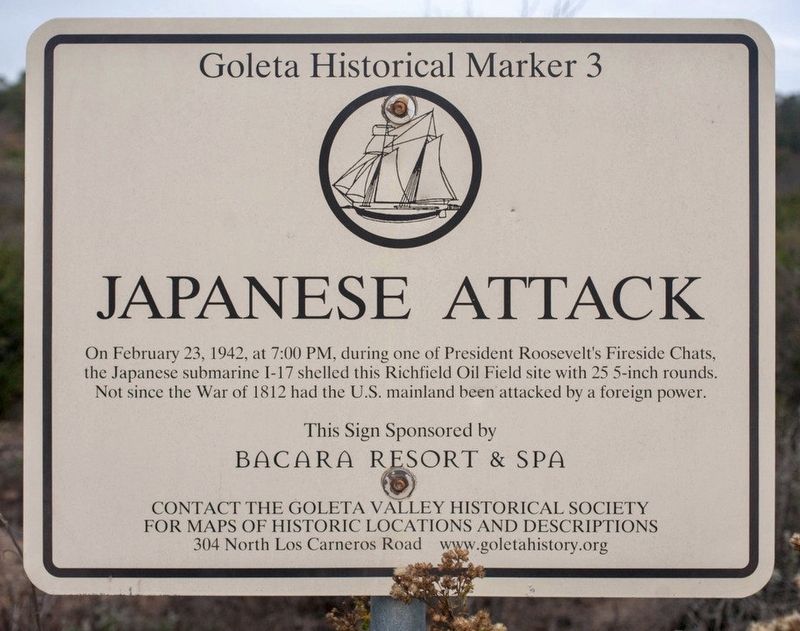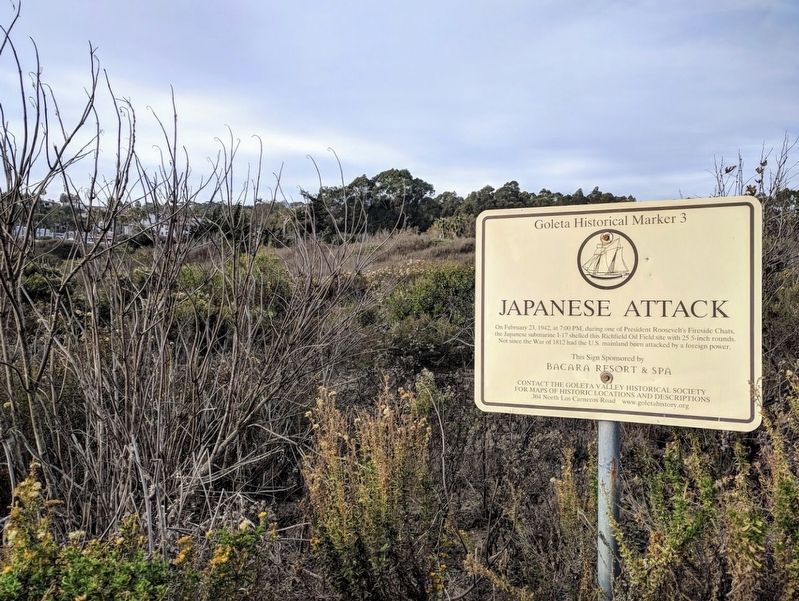Goleta in Santa Barbara County, California — The American West (Pacific Coastal)
Japanese Attack
On February 23, 1942, at 7:00 PM, during one of President Roosevelt's Fireside Chats, the Japanese submarine I-17 shelled this Richfield Oil Field site with 25 5-inch rounds. Not since the War of 1812 had the U.S. mainland been attacked by a foreign power.
Erected by Goleta Valley Historical Society and Bacara Resort & Spa. (Marker Number 3.)
Topics and series. This historical marker is listed in these topic lists: War, World II • Waterways & Vessels. In addition, it is included in the Former U.S. Presidents: #32 Franklin D. Roosevelt series list. A significant historical date for this entry is February 23, 1942.
Location. 34° 25.887′ N, 119° 54.972′ W. Marker is in Goleta, California, in Santa Barbara County. Marker can be reached from Hollister Avenue, 0.6 miles west of Cathedral Oaks Road, on the left when traveling west. The marker is along the walk to the Beach House at Haskell’s Beach. Touch for map. Marker is in this post office area: Goleta CA 93117, United States of America. Touch for directions.
Other nearby markers. At least 8 other markers are within 9 miles of this marker, measured as the crow flies. A different marker also named Japanese Attack (approx. half a mile away); Goleta Depot (approx. 3.7 miles away); Earle Ovington Terminal (approx. 4.6 miles away); Ovington's Hangar (approx. 5.2 miles away); Cold Spring Tavern (approx. 7.6 miles away); Old Stagecoach Route (approx. 7.9 miles away); Cold Spring Arch Bridge (approx. 8.2 miles away); Hope House (approx. 8.3 miles away). Touch for a list and map of all markers in Goleta.
Regarding Japanese Attack. Captain Kozo Nishino of the Japanese submarine I-17 was a naval reserve officer who, before the war, had commanded a merchant ship that stopped at this oil field to take on a cargo of oil. His 1942 attack damaged a derrick, pump house, pier, and catwalk. Even though he caused only minor damage, Nishino had achieved his purpose, which was to spread fear along the American West Coast.
Also see . . .
1. Bombardment of Ellwood. (Submitted on December 8, 2019.)
2. The Battle of Los Angeles. (Submitted on December 8, 2019.)
3. Japanese submarine I-17. (Submitted on December 8, 2019.)
Credits. This page was last revised on December 8, 2019. It was originally submitted on December 7, 2019, by Craig Baker of Sylmar, California. This page has been viewed 623 times since then and 93 times this year. Photos: 1, 2. submitted on December 7, 2019, by Craig Baker of Sylmar, California. • J. Makali Bruton was the editor who published this page.

